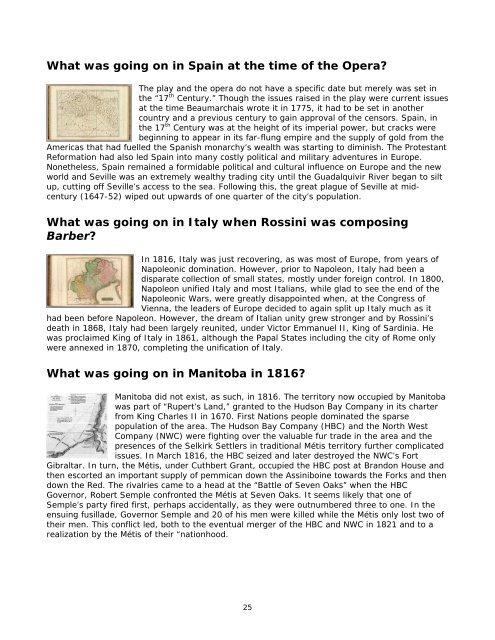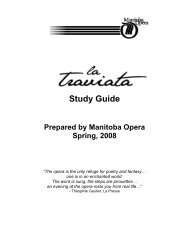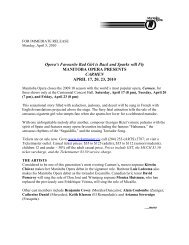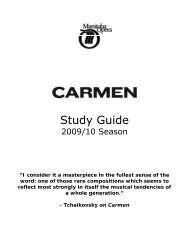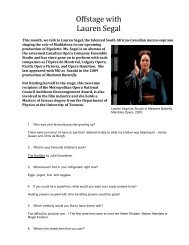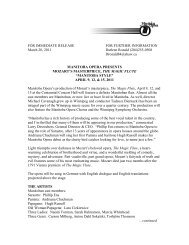The Barber of Seville Study Guide - Manitoba Opera
The Barber of Seville Study Guide - Manitoba Opera
The Barber of Seville Study Guide - Manitoba Opera
You also want an ePaper? Increase the reach of your titles
YUMPU automatically turns print PDFs into web optimized ePapers that Google loves.
What was going on in Spain at the time <strong>of</strong> the <strong>Opera</strong>?<br />
<strong>The</strong> play and the opera do not have a specific date but merely was set in<br />
the “17 th Century.” Though the issues raised in the play were current issues<br />
at the time Beaumarchais wrote it in 1775, it had to be set in another<br />
country and a previous century to gain approval <strong>of</strong> the censors. Spain, in<br />
the 17 th Century was at the height <strong>of</strong> its imperial power, but cracks were<br />
beginning to appear in its far-flung empire and the supply <strong>of</strong> gold from the<br />
Americas that had fuelled the Spanish monarchy’s wealth was starting to diminish. <strong>The</strong> Protestant<br />
Reformation had also led Spain into many costly political and military adventures in Europe.<br />
Nonetheless, Spain remained a formidable political and cultural influence on Europe and the new<br />
world and <strong>Seville</strong> was an extremely wealthy trading city until the Guadalquivir River began to silt<br />
up, cutting <strong>of</strong>f <strong>Seville</strong>’s access to the sea. Following this, the great plague <strong>of</strong> <strong>Seville</strong> at midcentury<br />
(1647-52) wiped out upwards <strong>of</strong> one quarter <strong>of</strong> the city’s population.<br />
What was going on in Italy when Rossini was composing<br />
<strong>Barber</strong>?<br />
In 1816, Italy was just recovering, as was most <strong>of</strong> Europe, from years <strong>of</strong><br />
Napoleonic domination. However, prior to Napoleon, Italy had been a<br />
disparate collection <strong>of</strong> small states, mostly under foreign control. In 1800,<br />
Napoleon unified Italy and most Italians, while glad to see the end <strong>of</strong> the<br />
Napoleonic Wars, were greatly disappointed when, at the Congress <strong>of</strong><br />
Vienna, the leaders <strong>of</strong> Europe decided to again split up Italy much as it<br />
had been before Napoleon. However, the dream <strong>of</strong> Italian unity grew stronger and by Rossini’s<br />
death in 1868, Italy had been largely reunited, under Victor Emmanuel II, King <strong>of</strong> Sardinia. He<br />
was proclaimed King <strong>of</strong> Italy in 1861, although the Papal States including the city <strong>of</strong> Rome only<br />
were annexed in 1870, completing the unification <strong>of</strong> Italy.<br />
What was going on in <strong>Manitoba</strong> in 1816?<br />
<strong>Manitoba</strong> did not exist, as such, in 1816. <strong>The</strong> territory now occupied by <strong>Manitoba</strong><br />
was part <strong>of</strong> “Rupert’s Land,” granted to the Hudson Bay Company in its charter<br />
from King Charles II in 1670. First Nations people dominated the sparse<br />
population <strong>of</strong> the area. <strong>The</strong> Hudson Bay Company (HBC) and the North West<br />
Company (NWC) were fighting over the valuable fur trade in the area and the<br />
presences <strong>of</strong> the Selkirk Settlers in traditional Métis territory further complicated<br />
issues. In March 1816, the HBC seized and later destroyed the NWC’s Fort<br />
Gibraltar. In turn, the Métis, under Cuthbert Grant, occupied the HBC post at Brandon House and<br />
then escorted an important supply <strong>of</strong> pemmican down the Assiniboine towards the Forks and then<br />
down the Red. <strong>The</strong> rivalries came to a head at the “Battle <strong>of</strong> Seven Oaks” when the HBC<br />
Governor, Robert Semple confronted the Métis at Seven Oaks. It seems likely that one <strong>of</strong><br />
Semple’s party fired first, perhaps accidentally, as they were outnumbered three to one. In the<br />
ensuing fusillade, Governor Semple and 20 <strong>of</strong> his men were killed while the Métis only lost two <strong>of</strong><br />
their men. This conflict led, both to the eventual merger <strong>of</strong> the HBC and NWC in 1821 and to a<br />
realization by the Métis <strong>of</strong> their “nationhood.<br />
25


